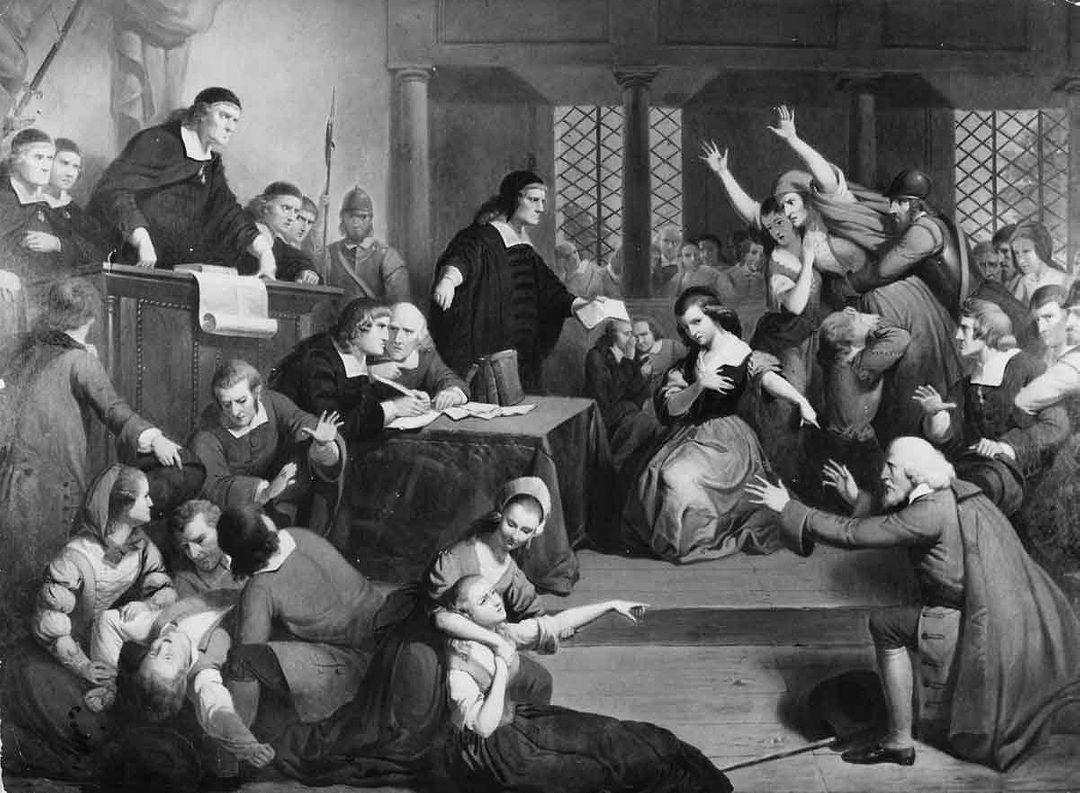Ghoulies, ghosties, and Puritans. Now that’s a potentially horrifying combination. And who better to pen them loose on the page than Concord author Nathaniel Hawthorne? Born in Salem, Massachusetts on July 4, 1804, Hawthorne came from a family steeped in history, scandals, and a curse put upon them by a young woman about to die.
In the 1630s, Hawthorne’s great-great-great grandfather, William Hathorne [original surname spelling], sailed from England to the new world where he could freely practice his Puritan beliefs. He eventually settled in Salem, MA and is remembered for ordering the whipping of a Quaker woman and driving her out of town.
William’s son, John Hathorne, was a judge in the Salem Witch Trials. Nicknamed “The Hanging Judge”, John Hathorne was merciless, hanging “the guilty” even after their accusers recanted. As shared in James R. Mellow’s biography, Nathaniel Hawthorne in His Times, before her hanging, a young woman convicted of witchcraft stood on the gallows and shouted a curse upon Judge John Hathorne and all his descendants. The curse came in the guise of the sea. Nathaniel’s father and uncle were both ship captains. A wild storm dragged Nathaniel’s uncle down into the depths, forever “lost at sea”. Then a fever contracted across the ocean claimed Nathaniel’s father when Nathaniel was only six years old.

Discovering the body of a drowned woman in Concord haunted Hawthorne for the rest of his days, and inspired him to write of her tragic plight in The Blithedale Romance.
| istock.com/sdominickWhen he came of age, Nathaniel tried to distance himself from the stain of Judge Hathorne’s atrocities and reviled name by adding a “w” to his last name, legally changing his surname to “Hawthorne”. But he could not escape his ancestral history or the spectre it raised. Soon, the tales emerged, initially published in magazines and then in his first novel Twice Told Tales. Many of Hawthorne’s stories featured Puritans, early colonial government, conflicts with England, and tensions with Native Americans, frequently interwoven with murmurings of witchcraft, strange conjurings, and unexplained phenomena.
On July 9th, 1842, Hawthorne married Sophia Peabody. The newlyweds moved to Concord, where they rented Ralph Waldo Emerson’s family home “The Old Manse” on Monument Street. Here, Nathaniel wrote more short stories and published them in Mosses from an Old Manse (1846).

In Concord the familial history that seeped into Hawthorne’s stories was supplemented by current events. For example, one early morning during the second year of Hawthorne’s residence at the Manse, nineteen-year old Concord schoolteacher Martha Hunt, despairing at her lack of prospects, placed her boots and folded handkerchief on the riverbank then walked into the Concord River to drown herself. When her items were discovered a search began. Accompanied by three others, Hawthorne set out in his boat to lend aid. Night fell. Suddenly, a search pole held by a young man in Hawthorne’s boat snagged something solid. The young man pulled. The water broke, moonlight revealing a body coming to the surface. Wrote Hawthorne in his journal: “[He] grasped her arm or hand; and I steered the boat to the bank, all the while looking at this dead girl, whose limbs were swaying in the water, close to the boat’s side…. For my own part, I felt my voice tremble a little, when I spoke, at the shock of the discovery; and at seeing the body come to the surface, dimly in the starlight. …. I never saw or imagined a spectacle of such perfect horror.” That scene haunted Hawthorne, and he later he wove the tragic scene into the final chapter of The Blithedale Romance. Over the next few years, he wrote several novels including The Scarlet Letter (1850) and The House of Seven Gables (1851).
Rivaled by Edgar Allen Poe, Hawthorne’s stories set the way for the “gothic literature” genre. Sometimes disguised in seemingly pleasant or innocent forms, a simmering darkness underlies many of Hawthorne’s tales, feeding upon the universal fear of the unknown - the often demonized “other.” If you’re ready to step into the shadows of Hawthorne’s writing and inspirations from his past, you could start with some of the following stories:
• The Birthmark and Doctor Heidegger’s Experiment, which will have you evaluating accepting mysterious drinks;
• Endicott and the Red Cross, featuring an association with Governor John Winthrop;
• Young Goodman Brown, where a Quaker woman is lashed through the streets of Salem and Puritans turn into wild devil worshippers and demons in the woods;
• Roger Malvin’s Burial, in which a young man’s guilty conscience from a fight with Native Americans leads to an eternal haunting;
• Feathertop: A Moralized Legend, and The Hollow of the Three Hills, where witches seek revenge or play deadly pranks with ghoulish fiends and not-so-innocent minds.
These stories and more can be found in several collections of Hawthorne’s works or, if you prefer to listen, many are available on the Barrow Bookstore’s Audio Series (free on YouTube).
Sources and Recommended Reading:
Mellow, J.R. (1980) Nathaniel Hawthorne In His Times, Houghton Mifflin Co., Boston
Hawthorne, Twice Told Tales and Mosses from an Old Manse


